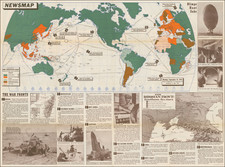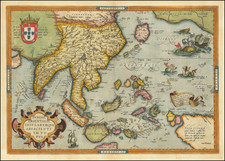Extremely Rare Map Showing the Extent of Damage in Hiroshima, Published in the Last Month of the War
Army-issued map printed in September 1945 showing the area destroyed by the detonation of the Little Boy atomic bomb. The damaged area can be seen to radiate out several miles from the center of the city. Damage in this area was nearly uniform, with nearly all buildings completely demolished, as evidenced from contemporary photos.
The base map was created in 1944 using data from a series of pre-war and captured Japanese maps. Topographic and other detail is extensive, reflecting the abilities of the US Army cartographers at adapting Japanese maps. Data regarding the "Bombed Out" area was collected using aerial photography, and the results are overlaid onto this base map in blue.
Aerial surveys of the bombed area were started nearly as soon as the atomic bomb was dropped. In the lower center left margin, a print shows the areas mapped by five different sorties which cover the area shown on the map. Mapping this area was a matter of urgency so that the full extent of the damage could be accurately studied prior to reconstruction. As such, this map would have proved invaluable in early-Cold War weapons design programs in understanding how newly developed atomic weapons could affect structures and cities. This is the earliest map we have been able to locate to display this information in a single visual.
In all, this is an extremely rare map of high historical importance.
The Bombing of Hiroshima
The detonation of the Little Boy atomic bomb on the 6th of August, 1945, was the culmination of years of research by civil and army engineers in the United States. The toll of this event would be extensive, with seventy thousand immediate casualties and over a hundred thousand more over the coming months.
Hiroshima was chosen as a target for this bombing as the city housed the Japanese Second General Army, which was in charge of homeland defense, as well as a number of industrial plants, with large weapon design factories.
While the merits of bombing Hiroshima are still debated, it is unquestionable that this event was one of the turning points in the 20th century. It unilaterally redefined how the Cold War would be fought, would drive the anti-nuclear peace protests of the sixties and seventies, and still remains a damaging legacy of the war in US-Japanese relations.
Rarity
OCLC does not list any examples of this map. We were unable to identify any additional examples of this mapping having been on the market. OCLC does not locate any other Army-issued maps printed before 1946 to show the extent of bomb damage in Hiroshima.









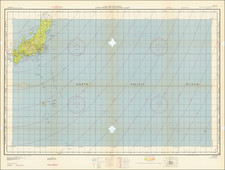
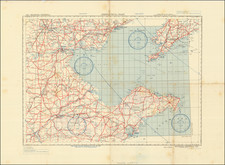
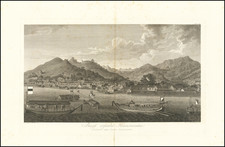
![(Second World War - D-Day - Omaha Beach) OMAHA BEACH-EAST (Colleville-sur-Mer) [:] FIRST BEACH OBSTACLE OVERPRINT [with:] OMAHA BEACH-WEST (Vierville-sur-Mer) [:] FIRST BEACH OBSTACLE OVERPRINT. NP, April 21, 1944 (with overprinting of information dated May 12).](https://storage.googleapis.com/raremaps/img/small/100123.jpg)
